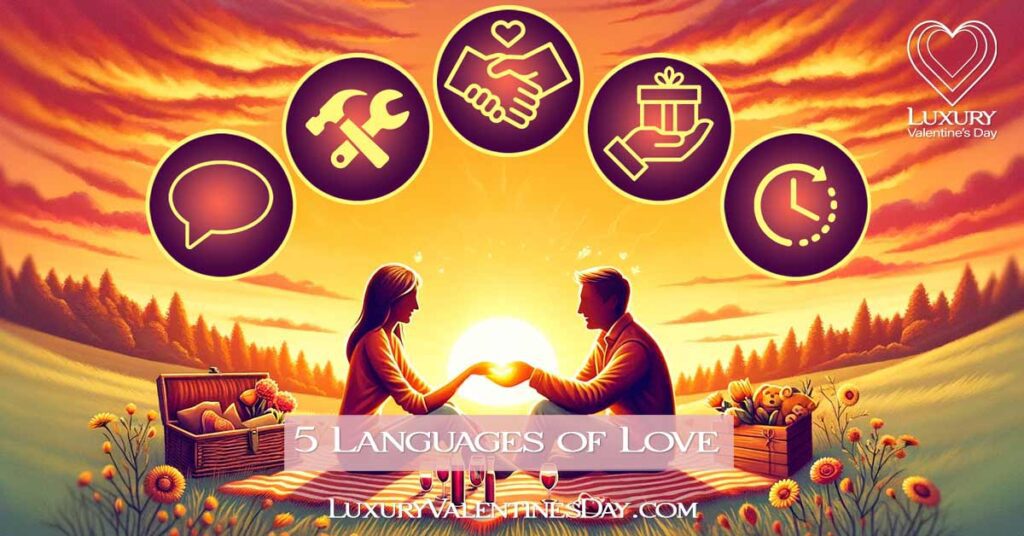
Table of Contents
ToggleUnlock the Power of Love Languages: Transform Your Romantic Connections
Ever wondered why some romantic gestures make your heart flutter, while others fall flat? Enter the world of “The 5 Love Languages” by Dr. Gary Chapman. This revolutionary concept has transformed how we perceive and express love in relationships. Whether it’s cherishing quality time or treasuring heartfelt words, understanding these love languages can turn an ordinary Valentine’s Day into an extraordinary celebration of love. In this article, we delve deep into each language, offering you the keys to unlock a more fulfilling, deeper connection with your loved one.
Key Takeaways
- Discover Each Love Language: Unravel the unique aspects of Words of Affirmation, Acts of Service, Receiving Gifts, Quality Time, and Physical Touch.
- Identify Your Love Language: Learn how to determine your own love language and understand its profound impact on your relationships.
- Communicate Effectively: Gain insights on expressing and receiving love in ways that resonate deeply with you and your partner.
- Enhance Your Valentine’s Day: Explore creative ideas to celebrate Valentine’s Day, tailored to the specific love languages of you and your loved one.
- Strengthen Bonds: Embrace the power of love languages to fortify the emotional connection and intimacy in your relationships.
Exploring the Five Love Languages

Understanding the five love languages – Words of Affirmation, Acts of Service, Receiving Gifts, Quality Time, and Physical Touch – is like unlocking a treasure chest of relationship wisdom. It’s not just about knowing what they are, but about applying them to deepen connections, as Dr. Gary Chapman [1] illustrates in his insightful book.
1. Words of Affirmation
This language thrives on verbal acknowledgments of affection, including compliments, words of appreciation, verbal encouragement, and often frequent digital communication like texting and social media engagement. For instance, a simple “I love how you always think of others” can light up someone’s day. In today’s digital age, sending a heartfelt message or posting a sweet comment on your partner’s social media post can also be powerful.
2. Acts of Service
For those who prefer this language, actions speak louder than words. It’s all about doing things you know your partner would like, such as cooking a meal, doing the laundry, or running errands. It’s characterized by the mantra “Actions speak louder than words.” In a modern context, it could be as simple as taking over a stressful task or managing a digital calendar for your partner.
3. Receiving Gifts
This love language isn’t necessarily materialistic. It could be as simple as bringing a souvenir from a business trip or picking up a favorite snack. It’s the thoughtfulness and effort behind the gift that matters. In a digital era, this could even extend to gifting e-books or online courses, showing that you’re thinking of your partner even when you’re not physically together.
4. Quality Time
This language is all about undivided attention. No televisions, smartphones, or other distractions. Whether it’s a quiet conversation at a café or a leisurely walk in the park, it’s about spending meaningful time together and engaging in deep conversations or shared activities.
5. Physical Touch Love Language
To people who speak this language, nothing is more impactful than physical contact. Be it a hug, a kiss, holding hands, or sitting close together on the couch. It’s about feeling physically close to your partner. In long-distance relationships, this could translate to planning visits or even virtual reality experiences that simulate physical presence.
By understanding and applying these five love languages in your daily life and especially around Valentine’s Day, you can enhance your relationship, ensuring that both you and your partner feel truly loved and appreciated in ways that resonate most deeply with each of you.
| Love Language | How to Communicate | Actions to Take |
|---|---|---|
| Words of Affirmation | Use affirming and appreciative language | Write love notes, give compliments, express love and gratitude verbally |
| Acts of Service | Show care through helpful actions | Do chores, prepare meals, handle tasks they don’t enjoy |
| Receiving Gifts | Give thoughtful presents | Choose gifts that reflect their interests, make personalized gifts |
| Quality Time | Give undivided attention | Plan intimate outings, engage in meaningful conversations, spend time doing shared activities |
| Physical Touch | Use touch to convey warmth and love | Hold hands, hug, kiss, offer massages, engage in physical closeness |
Books on the 5 Love Languages
Finding Your Love Language
Identifying your own love language is an enlightening journey, one that can significantly enhance your understanding of yourself and how you interact in relationships. It’s not just about knowing what makes you feel loved; it’s also about recognizing how you naturally express love to others.
The first step is introspection. Reflect on what actions or words from your partner make you feel most loved and appreciated. Is it when they give you a heartfelt compliment, spend quality time with you, present you with a thoughtful gift, lend a helping hand, or show affection through touch? These reflections are clues to your primary love language.
Another effective way to discover your love language is through quizzes and assessments. Dr. Gary Chapman’s official ‘5 Love Languages‘ quiz is a popular tool that offers insight into your personal love language preferences. This quiz breaks down your affinity for each of the five languages: Words of Affirmation, Acts of Service, Receiving Gifts, Quality Time, and Physical Touch, providing a clearer picture of what resonates most with you.
Online assessments are not just tools for individual discovery; they can also be a fun, engaging activity for couples. Taking the quiz together and sharing your results can lead to meaningful conversations about how you both give and receive love. It’s a valuable exercise that can strengthen your bond and improve the way you communicate affection.
Incorporating these quizzes and self-reflection exercises into your relationship routine, especially around occasions like Valentine’s Day, can transform how you express love and appreciation for each other. Understanding your primary love language isn’t just about enhancing romantic relationships; it’s also valuable in fostering better connections with friends, family, and colleagues, as it influences your overall approach to relationships.
With these insights, you can more effectively communicate your needs and desires to your partner, paving the way for a more harmonious and fulfilling relationship. So, why not take a moment to explore your love language today? It could be the key to unlocking a deeper, more meaningful connection with your loved ones.
Love Languages in Action

Putting the five love languages into action is where the real magic happens in relationships. Whether it’s Valentine’s Day or any other day, expressing love in the language your partner understands best can transform your relationship. Let’s dive into how to express each love language with some creative and luxurious ideas for Valentine’s Day.
1. Words of Affirmation: Crafting Verbal Masterpieces of Love
Express your affection through thoughtful and personalized verbal gestures that resonate deeply with your partner. Discover how the right words can become the most precious gifts. This love language thrives on verbal expressions of love, appreciation, and affirmation. It’s all about making your partner feel valued and cherished through your words.
- Personalized Love Notes: Go beyond the standard “I love you” and write a series of love notes. Each note could express something you adore about your partner, a cherished memory, or your hopes for the future together. Present these notes in a luxurious, handcrafted box or scattered throughout the day for a continuous reminder of your love.
- Custom Poetry or Song: If you have a flair for writing, penning a poem or a song tailored to your partner can be incredibly moving. Recite it over a candlelit dinner or have it professionally printed on high-quality paper, framed for lasting significance.
- Public Declarations: If your partner appreciates public displays of affection, consider expressing your love in a grand manner. This could be a surprise declaration of love on a social media platform, a message on a local radio station, or even a banner in a place significant to both of you.
- Recorded Message: In our digital age, a recorded video or audio message adds a personal touch. Record yourself expressing your love and gratitude, recounting special moments, or even reading a love letter. This digital keepsake can be revisited and cherished for years to come.
- Book of Affirmations: Create a bespoke book filled with affirmations, reasons why you love them, and quotes that resonate with your relationship. Have it professionally bound for an elegant touch, turning your words into a timeless gift.
For those who speak the Words of Affirmation love language, these gestures can resonate more deeply than any physical gift. It’s about making them feel seen, heard, and appreciated through the power of words, turning Valentine’s Day into an extraordinary celebration of your unique bond.
2. Acts of Service: Demonstrating Devotion Through Deeds

This love language appreciates thoughtful actions that make life easier or more pleasant. It’s about showing love through helpful deeds that demonstrate your commitment and care. Show your love in the most practical and caring way – by doing. Find out how thoughtful actions can speak volumes and transform everyday moments into expressions of deep love.
- Plan a Surprise Day Off: Organize a day where every detail is taken care of for your partner. This could include handling all their usual chores, arranging a relaxing spa appointment, or even a peaceful day at a serene retreat. The key is to allow them to unwind without lifting a finger, showing your understanding of their needs and your desire to make life more enjoyable for them.
- Culinary Delights: If you’re skilled in the kitchen, prepare a gourmet meal with all their favorite dishes. Set a beautiful table with fine china and candles, transforming a regular meal into a luxurious dining experience. For added extravagance, hire a professional chef to prepare a meal at home, offering a fine-dining experience in the comfort of your own space.
- Personalized Errand Service: Think of the tasks your partner dreads and take them off their hands for the day or week. Whether it’s running errands, cleaning the house, or organizing a cluttered space, your efforts to ease their burden speak volumes about your love and dedication.
- DIY Projects or Home Improvements: If your partner has been talking about a home improvement project, take the lead on making it happen. Whether it’s redecorating a room, building a piece of furniture, or fixing something, completing a project for them can be a powerful act of love.
- Plan an Unforgettable Experience: Organize an entire day or weekend tailored to their interests. This could include a private tour of an art exhibit, a day at a racing track, a hot air balloon ride, or tickets to a sought-after event. The act of service here is in the thoughtful planning and organization, ensuring they have an incredible experience without any stress or effort on their part.
For someone whose love language is Acts of Service, these thoughtful actions demonstrate that you not only understand their desires and needs but are also willing to put in the effort to make them happy. It’s these acts of service, big or small, that deepen the bond and show your love in a very tangible way.
3. Receiving Gifts: Thoughtful Tokens of Affection
For those who speak the language of Receiving Gifts, it’s the thought and effort behind the gift that truly count. Explore how to make every present a meaningful expression of your love, enhancing the bond you share.
When it comes to Receiving Gifts, it’s not about the price tag or the grandeur but the sentiment and thoughtfulness behind each gift. It’s about showing you listen, care, and understand what brings joy to your partner.
- Personalized Gifts: Customized gifts resonate deeply for those who appreciate this love language. Consider a piece of custom-made jewelry with a special inscription, a commissioned artwork depicting a cherished memory, or a personalized book that reflects their interests or your journey together.
- Experience Gifts: Sometimes, the best gifts aren’t things but experiences. Plan a surprise getaway to a destination they’ve always wanted to visit, book a private culinary class if they love cooking, or secure tickets to a sought-after event or concert. These experiences become treasured memories, valued far more than material items.
- Handcrafted Surprises: A gift you’ve made yourself can have an enormous impact. Whether it’s a handmade photo album, a knitted scarf, or a DIY home décor piece, the time and effort you invest are what make these gifts so special.
- Gifts That Keep on Giving: Subscriptions or memberships can be a delightful surprise. Whether it’s a subscription to a premium wine club, a gourmet food delivery service, or a membership to a museum or botanical garden, these ongoing gifts remind your partner of your love throughout the year.
- Luxury Items: For a touch of extravagance, opt for a luxury item that your partner wouldn’t typically buy for themselves. This could be a high-end watch, a designer handbag, or a piece of tech gadgetry. The key is in choosing something that aligns with their tastes and interests.
Incorporating the element of surprise and showing that you’ve put real thought into understanding what delights them can make the act of giving gifts a deeply emotional and meaningful gesture. Remember, it’s the intention and the love behind the gift that truly embodies the language of Receiving Gifts.
4. Quality Time: Cherishing Every Moment Together
For those who treasure Quality Time, undivided attention and shared moments are the essence of feeling loved. Discover how dedicating your time and presence can create unforgettable memories and deepen your bond.
In the language of Quality Time, it’s all about giving your partner your full and undivided attention. It’s these moments of togetherness, free from the distractions of everyday life, that truly strengthen your connection.
- Plan a Special Day or Evening: Organize a day or evening that’s all about the two of you. This could be a picnic in a scenic location, a leisurely stroll through a botanical garden, or a candlelit dinner at a quiet restaurant. The goal is to create a space where you can focus solely on each other and enjoy each other’s company.
- Take on a New Adventure Together: Embarking on a new experience can be a thrilling way to spend quality time. This might be a cooking class, a dance lesson, or even something more adventurous like kayaking or a hot air balloon ride. The joy lies in experiencing something new together, creating shared memories.
- Tech-Free Retreats: In our digitally connected world, setting aside time to disconnect from technology can be a gift in itself. Plan a tech-free retreat, even if it’s just for a day. Turn off your phones, stay away from screens, and focus on each other. This could be a day spent in nature, a visit to a spa, or simply relaxing at home with books and board games.
- Cultural and Artistic Experiences: Sharing a cultural experience like visiting a museum, attending a theater performance, or enjoying a live concert can be a meaningful way to spend quality time. It allows you both to indulge in shared interests and have stimulating conversations about the experience.
- Quiet Nights In: Sometimes, quality time can be as simple as a quiet night at home. Cooking a meal together, watching a movie, or simply sitting by the fireplace can be deeply comforting and intimate. It’s about being present and enjoying each other’s presence, without the need for extravagance.
For those whose love language is Quality Time, the luxury lies not in lavish gifts or grand gestures, but in the simple, undistracted presence and attention you give. It’s these moments that become the foundation of a strong, loving relationship.
5. Physical Touch: Connecting Through the Power of Touch

For individuals who resonate with Physical Touch, affectionate gestures and tactile expressions of love are pivotal. Explore how the power of a simple touch can communicate volumes and strengthen the emotional bond in your relationship.
Physical Touch, as a love language, goes beyond mere physical intimacy; it’s about conveying love, safety, and comfort through touch. It’s in these small, tactile moments that individuals feel most connected and valued.
- Prioritize Everyday Affection: Incorporate more physical touch into your daily routine. Simple acts like holding hands while walking, a goodbye kiss before work, or a welcoming hug can make a significant difference. These small gestures of affection are constant reminders of your love.
- Create a Spa Experience at Home: Transform your home into a tranquil spa for an evening. Indulge in giving each other massages with luxurious oils, perhaps followed by a relaxing bath together. This not only allows for physical closeness but also creates a space for emotional intimacy.
- Plan Physical Activities Together: Engage in activities that allow for physical closeness. Dancing, for instance, whether in a class or in your living room, can be an intimate way to connect. Hiking or partner yoga are also great options to explore the outdoors while staying physically close.
- Intimate Evenings: Plan a romantic evening that centers around physical closeness. This could include cuddling under the stars, a movie night with a cozy blanket, or simply lying together in a hammock. The aim is to feel connected through physical presence.
- Surprise Physical Gestures: Small surprises can have a big impact. A surprise hug from behind, a gentle kiss on the forehead, or a playful tickle can bring a smile to your partner’s face. These spontaneous touches can be deeply heartwarming and convey your affection in a playful yet meaningful way.
For those whose primary love language is Physical Touch, these gestures are crucial in nurturing the relationship. They’re a powerful way to communicate love and ensure your partner feels cherished and secure. In the realm of Physical Touch, it’s the warmth and comfort of your presence that speaks the loudest.
The Impact of Love Languages in Relationships: Nurturing Deeper Connections

The concept of love languages has revolutionized the way we understand and nurture relationships. By understanding and applying Dr. Gary Chapman’s “The 5 Love Languages,” couples can experience a profound transformation in their emotional connection. This section explores the benefits of this understanding and includes insights from relationship experts.
Enhanced Communication
One of the primary benefits of understanding love languages is improved communication. When partners know each other’s love languages, they can express affection in ways that are most meaningful to the other person. This understanding bridges gaps in communication, reducing misunderstandings and fostering a deeper emotional connection.
Strengthened Emotional Bond
Each act of love expressed in the partner’s primary love language reinforces the emotional bond. Relationship experts underscore that feeling loved and understood is a fundamental human need. When this need is met in a relationship, it leads to increased feelings of security and happiness.
Greater Empathy and Understanding
Recognizing and respecting each other’s love languages fosters empathy. It allows partners to see the world from each other’s perspectives, understanding their emotional needs and how they differ from their own. This understanding is crucial in nurturing a compassionate and fulfilling relationship.
Reduced Conflict
Many relationship conflicts stem from miscommunications about emotional needs. By applying the principles of love languages, couples can address the root causes of conflicts, leading to more harmonious relationships. Experts point out that when partners feel loved in their preferred language, they are more likely to reciprocate, creating a positive cycle of love and appreciation.
Personal Growth and Self-awareness
Discovering one’s own love language is not just beneficial for relationships but also for personal growth. It encourages self-awareness and introspection, helping individuals understand their emotional needs and how they connect with others.
Expert Insights
Relationship counselors and psychologists often use the concept of love languages in therapy and counseling. They note that couples who understand and apply these principles tend to have more resilient and satisfying relationships. The love languages framework is praised for its simplicity and effectiveness in helping couples navigate the complexities of emotional expression and reception.
The impact of understanding and applying the five love languages in relationships is profound. It enhances communication, strengthens emotional bonds, fosters empathy, reduces conflict, and promotes personal growth. These benefits, highlighted by relationship experts, underscore the importance of love languages in building and maintaining healthy, loving relationships.
Navigating Challenges: Overcoming Obstacles in Love Language Communication
While understanding the five love languages can significantly enhance relationships, navigating the application of these languages comes with its own set of challenges and misunderstandings. This section offers insights into overcoming these hurdles and provides tips for effective communication and adaptation, ensuring that love languages become a source of joy rather than frustration.
Common Misunderstandings:
- Assuming One-Size-Fits-All: A frequent misunderstanding is assuming that what works for one person will work for another. Each individual’s preference for how they receive love can be vastly different. It’s crucial to remember that love languages are highly personal and what resonates with one person might not hold the same value for another.
- Neglecting Personal Love Language: Often, individuals may focus solely on their partner’s love language while neglecting their own. This imbalance can lead to feelings of unfulfillment. It’s important to communicate your own needs clearly and ensure that both partners’ emotional needs are met.
- Overdependence on Love Languages: While love languages are a powerful tool, they are not a cure-all solution. Relying solely on them without addressing deeper relationship issues can lead to challenges. It’s essential to use love languages as one part of a broader strategy for a healthy relationship.
Tips for Effective Communication and Adaptation:
- Open Dialogue: Regularly discuss your love languages with your partner. Open and honest communication is key to understanding and meeting each other’s emotional needs. This dialogue should also include discussions about changes in your love language preferences over time.
- Flexibility and Adaptation: People evolve, and so do their love languages. Be open to the possibility that your or your partner’s love language might change and be willing to adapt accordingly. This flexibility can help keep the relationship fresh and responsive to each individual’s current emotional needs.
- Balancing Languages: It’s important to strike a balance between all five love languages. While you might have a primary language, incorporating elements of the other languages can enrich the relationship and provide a well-rounded expression of love.
- Understanding Cultural Nuances: Cultural backgrounds can influence how love languages are expressed and received. Be mindful and respectful of these nuances, and strive to understand how your partner’s cultural context shapes their perception of love.
- Professional Guidance: If you encounter persistent challenges, consider seeking guidance from a relationship counselor. Professionals can provide personalized advice and strategies tailored to your specific relationship dynamics.
Navigating the challenges associated with love languages requires patience, understanding, and effort from both partners. By addressing these common misunderstandings and employing effective communication strategies, couples can use love languages to enhance their relationship, creating a stronger, more empathetic bond.
Examining the Critiques: Understanding the Limitations of Love Language Theory

Here I want to delve into various criticisms and challenges associated with the love language theory, exploring different perspectives and limitations. This balanced approach helps in understanding the complexity and nuances of relationship dynamics beyond the scope of the five love languages.
While Dr. Gary Chapman’s “The 5 Love Languages” has offered valuable insights into relationship dynamics, it’s not without its criticisms and limitations. Understanding these critiques can help in applying the love languages concept more effectively and realistically.
Lack of Empirical Evidence: One of the primary criticisms of the love languages theory is the lack of empirical, scientific research backing it. The concept, while based on Chapman’s extensive experience as a marriage counselor, hasn’t been extensively tested in controlled psychological studies. This lack of empirical evidence leads some experts to question the universality and scientific validity of the theory.
Over-Simplification of Complex Emotions: Critics argue that the love languages theory oversimplifies human emotions and relationship dynamics. Relationships are complex, and the idea that everyone fits neatly into one of five categories can be seen as reductive. Emotional needs and expressions of love can be more varied and fluid than the five categories suggest.
Cultural and Individual Differences: The theory may not account for cultural and individual variations in expressing and receiving love. Different cultures have unique ways of expressing affection, and these nuances might not align with the five love languages. Moreover, individual preferences and personalities play a significant role in how love is expressed and perceived.
Potential for Misuse: There’s a concern that the love languages concept could be misused. For example, a partner might use their love language as an excuse for not meeting their partner’s needs (“I’m just not good at giving gifts” or “I don’t like physical touch”). This could lead to neglecting the effort to understand and fulfill their partner’s emotional needs.
Neglecting Other Relationship Factors: Relying solely on love languages can lead to overlooking other crucial factors in a healthy relationship, such as mutual respect, trust, and shared values. While understanding love languages can enhance a relationship, it’s not a panacea for all relationship issues.
Evolution Over Time: The theory doesn’t always account for the fact that individuals’ love languages can change over time due to personal growth, life experiences, or changes in the relationship itself. This fluidity means that understanding a partner’s love language is an ongoing process.
While the love languages theory is a useful tool in understanding and improving relationship dynamics, it’s important to approach it as one component of a broader relationship strategy. Acknowledging its limitations and incorporating other aspects of relationship-building, such as communication skills, empathy, and shared experiences, can lead to a more holistic and fulfilling partnership. [2] [3] [4]
Embracing Love Languages for Relationship Bliss

As we wrap up our exploration of Dr. Gary Chapman’s “The 5 Love Languages,” it’s clear that understanding and applying these concepts can be a game-changer for any relationship. Whether it’s through Words of Affirmation, Acts of Service, Receiving Gifts, Quality Time, or Physical Touch, each language offers a unique pathway to deeper emotional connections and understanding.
The beauty of love languages lies in their ability to transform the simplest moments into profound expressions of love. By learning your own love language and that of your partner, you open up a world of deeper empathy, reduced misunderstandings, and heightened intimacy. This understanding is not just about making grand romantic gestures on Valentine’s Day but about enriching your day-to-day interactions.
As Valentine’s Day approaches, consider this an opportunity to put these insights into practice. Whether it’s crafting a heartfelt note, planning a thoughtful day, giving a meaningful gift, dedicating quality time, or expressing your affection through touch, let your actions speak the language of your partner’s heart. This Valentine’s Day, challenge yourself to go beyond the conventional. Use your understanding of love languages to create an experience that truly resonates with your partner’s emotional needs.
Remember, the journey of exploring love languages is ongoing and ever-evolving. As you and your partner grow and change, so may your love languages. Regularly revisiting and discussing your love languages can keep your relationship dynamic and thriving.
The power of love languages extends far beyond Valentine’s Day; it’s a tool for nurturing your relationship every day. By embracing these languages, you embark on a journey of deeper connection, appreciation, and love. This Valentine’s Day, let the love languages guide you in creating an unforgettable celebration of your unique bond, setting the tone for a relationship filled with understanding, respect, and endless love.
FAQs (Frequently Asked Questions): Understanding the 5 Love Languages

Here we address some common questions regarding the 5 Love Languages, providing insights and clarity to further enhance your understanding of this impactful relationship tool.
What are the 5 Love Languages?
The 5 Love Languages, conceptualized by Dr. Gary Chapman, are five distinct ways individuals express and experience love. They include:
- Words of Affirmation
- Acts of Service
- Receiving Gifts
- Quality Time
- Physical Touch.
Each person tends to have one or two predominant languages that resonate most with them.
How can I discover my partner’s love language?
Discovering your partner’s love language can be achieved through observation, conversation, and experimentation. Notice how they express love to you and others, as this is often a reflection of their own love language. Engage in open discussions about how they prefer to give and receive love. You can also try expressing love in all five languages and see which elicits the strongest positive response.
Are love languages scientifically proven?
While the 5 Love Languages are not based on empirical scientific research, they are grounded in Dr. Chapman’s extensive experience as a marriage counselor. Many relationship experts and therapists have found the concept useful in helping couples improve their communication and strengthen their bond.
Can love languages change over time?
Yes, love languages can evolve over time. Life experiences, personal growth, and changes in circumstances can all influence one’s primary love language. It’s important to maintain open communication and regularly check in with each other to understand any changes in love language preferences.
How do love languages apply to long-distance relationships?
In long-distance relationships, love languages can still be effectively expressed. Words of Affirmation can be shared through calls, texts, or emails. Acts of Service can include helping with online tasks or planning future visits. Receiving Gifts can involve sending care packages or online gifts. Quality Time can be spent together virtually through video calls. Physical Touch is challenging but can be expressed through planning visits or sending physical items like a shirt with your scent.
Is it possible to have more than one primary love language?
Absolutely. Many people find that they resonate with more than one love language. Having multiple primary love languages means you appreciate and feel loved through several forms of expression.
How can I express love languages when my partner and I are very different?
The key is understanding and respecting each other’s love languages, even if they differ from your own. It involves stepping out of your comfort zone to express love in a way that your partner appreciates. Communication and willingness to adapt are crucial in these situations.
Do love languages apply only to romantic relationships?
While commonly applied to romantic relationships, love languages are also relevant in friendships, family dynamics, and even professional relationships. Understanding how different people express and prefer to receive appreciation can enhance various types of relationships.
These FAQs offer a basic understanding of the 5 Love Languages and their application in different scenarios. By incorporating these principles into your relationships, you can foster deeper understanding, empathy, and connection with your loved ones.
NOTE: The 5 LOVE LANGUAGES ®, THE FIVE LOVE LANGUAGES ® and LOVE LANGUAGE® are trademarks owned by The Moody Bible Institute of Chicago. Dr. Gary D. Chapman is the author of the New York Times bestselling book The 5 Love Languages.
References
[1] Chapman, G. (1992). The five love languages: How to express heartfelt commitment to your mate. Chicago, IL: Northfield. https://scholar.google.com/scholar_lookup?hl=en&publication_year=1992&author=G.+Chapman&title=The+five+love+languages%3A+How+to+express+heartfelt+commitment+to+your+mate
[2] “6 Problems With The Love Languages, From A Couples Therapist” by Licensed Marriage and Family Therapist
By Linda Carroll, M.S., LMFT, published December 1, 2020 on The MBG Relationships website https://www.mindbodygreen.com/articles/ways-youre-thinking-about-the-love-languages-wrong
[3] “Walking the walk, talking the talk: Love languages, self-regulation, and relationship satisfaction” by Selena Bunt and Zoe J. Hazelwood, published February 2017, on Personal Relationsips website https://onlinelibrary.wiley.com/doi/abs/10.1111/pere.12182
[4] [PDF] researchgate.net “Speaking the language of relational maintenance: A validity test of Chapman’s Five Love Languages” by N Egbert, D Polk, published online August 23 2006, Communication Research Reports, 2006, Taylor & Francis https://scholar.google.com/scholar_lookup?hl=en&volume=23&publication_year=2006&pages=19-26&journal=Communication+Research+Reports&issue=1&author=N.+Egbert&author=D.+Polk&title=Speaking+the+language+of+relational+maintenance%3A+A+validity+test+of+Chapman%27s+five+love+languages
Related Posts
- 10 Romantic Date Night Restaurants in Greensboro, NC: Culinary Love Affairs
- 10 Romantic Date Night Restaurants in Wilmington, NC: Your Guide to Unforgettable Evenings
- Classic Butter Cookies Recipe for Valentine’s Day: A Timeless, Buttery Delight
- Edible Glitter Decorated Cookies: Tips for Sparkling Designs
- The Dark Truth About Valentine’s Day
- Date Ideas That Start with V: Vibrant and Versatile Dates



















